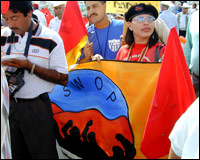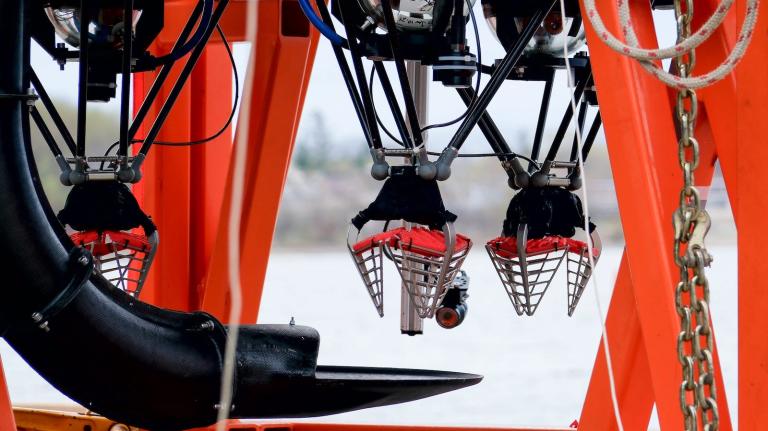
Tomasita González.
What work do you do?
I work as a community organizer at SouthWest Organizing Project, based in Albuquerque, N.M.
What does your organization do?
For over a quarter century, SWOP has worked to build an environmental-justice movement in disenfranchised, working, and people-of-color communities. In the ’90s, we sought to challenge the mainstream “Group of Ten” environmental organizations with a letter demanding that affected communities — those suffering most from industrial and human-produced toxins and pollution — have a seat at the table in shaping the environmental movement.
What are you working on at the moment?
We’re trying to get the New Mexico state legislature to adopt an environmental-justice bill and memorial.
How do you get to work?
I carpool with coworkers when possible.
What long and winding road led you to your current position?
I and my community are struggling for the right to access clean, safe drinking water. SWOP came in and helped organize, guide, and empower us to stand up to elected officials, etc., in order to resolve the problem. I saw changes within the officials, etc., so I decided to stay and share my struggle and experience and be a support to others.
Where were you born? Where do you live now?
I was born, raised, and am currently living in the South Valley, which is located in Albuquerque, N.M.
What has been the best moment in your professional life to date?
When we were organizing for environmental-justice legislation and some elected officials treated the polluters like we normally get treated — like we’re crazy.
What environmental offense has infuriated you the most?
What really upsets me is when our elected officials hand out permits to polluters, knowing our communities are already overloaded with toxins and environmental hazards and degradation.
Where do you think environmentalists and social-justice advocates can find common cause?
During the last year, whole communities and cultures were found to be expendable following natural disasters all over the world. In the U.S., the richest country in the world, the poor and working class — and yes, African Americans — of the Gulf Coast were left to die in a predicted disaster in the wake of Hurricane Katrina. The threat of climate change and a world energy shortage looms mightily over the world’s overwhelmingly poor population. Environmentalists and social-justice advocates must find common ground not only in combating the effects of corporate globalization on the environment, but also in organizing to meet the immediate needs of families all over the world left out of existing power structures.
Do you see environmental ills disproportionately afflicting the communities where you live and work?

González and friends take their message to the streets.
Photo: SWOP.
Of course. There are two environmental movements we can speak of: one is a middle-class (mostly) white environmental movement and the other is a very diverse grouping of locally based groups working hard to end the environmental degradation of their communities. A central tenet of this movement is that people have the right to live, play, and work in a healthy and safe environment. Commonly referred to as the EJ movement, this work receives little attention in the press despite its significant accomplishments toward holding corporations and governments environmentally accountable — not to mention the (other) environmental movement, which often is perceived to act as if humans are parasites.
How can the environmental movement cast a wider net culturally and become a bigger-tent issue politically?
The environmental movement must come to the realization that humans are part of the environment.
Who is your environmental hero?
Jeanne Gauna, one of the cofounders of SWOP. She passed away a few years ago. She really knew how to engage, motivate, and empower people. She made me feel like anything could be done as long as we stuck together and stood up. Now, I know why she said it wouldn’t be easy, but things are getting done.
What’s your environmental vice?
Sometimes I stretch the truth about my carpooling habits.
How do you spend your free time?
I come from a soccer family (myself and my two boys), so my free time is spent in practice or at games.
What’s your favorite meal?
As long as it has chile (hot preferred), I’m good.
What’s your favorite place or ecosystem?
I love to go to the Bosque along the Rio Grande with my kids. I hope my kids will be able to take their kids there too.
If you could institute by fiat one environmental reform, what would it be?
It would be that polluters and governments would have to complete an impact study prior to issuing permits.
Who was your favorite musical artist when you were 18? How about now?
I love to dance to cumbia no matter the artist!
What’s your favorite TV show?
I really don’t have time for TV, but I’d say the game show 100 Mexicanos Dijeron.
Which actor would play you in the story of your life?
There’s no one in Hollywood quite like me. But my kids want J.Lo to play me in a movie!
If you could have every InterActivist reader do one thing, what would it be?
Now more than ever, we should value the importance of community-based institutions where disenfranchised, everyday people can impact the decisions that affect our lives — decisions increasingly made by special interests, corporate interests, and patron politicians. Donate to your friendly, local community-based organization!

Tomasita González, of SouthWest Organizing Project.
SWOP and Go
Albuquerque and Santa Fe, and probably other cities and towns in New Mexico, are seeing lots of development of housing for new residents. What are the environmental implications? How seriously is the water supply strained? Are underprivileged or minority communities affected? — Mark Stephen Caponigro, New York, N.Y.
Thanks for the question, Mark. SouthWest Organizing Project is currently looking to study race and class and residential water usage in the state. Who’s using all this water, and how can we reduce that use? As I write, Intel (you know, inside your computer) uses millions of gallons of water per day while residents and children who live on Pajarito Mesa don’t have access to clean, safe, and running water, electricity, or other basic services.
A number of Navajo, and perhaps other Native Americans, are employed in uranium-mining operations in New Mexico. This sort of work is said to be unhealthful for workers. Is that true? Is it part of a pattern of overlooking the health issues of Native Americans? — Mark Stephen Caponigro, New York, N.Y.
The complete nuclear cycle runs its course in New Mexico. From the testing of the first atomic bomb at the Trinity site, to the mining of uranium (yes, mostly from indigenous lands), to the research and development of the next generation of nuclear weaponry in our many national labs, to the storage of weapons of mass destruction, and finally to the dumping of nuclear waste in southern New Mexico’s Waste Isolation Pilot Program.
Uranium mining on Native land has had devastating health implications not only for workers but also for whole pueblos and communities.
As a kind of “nuclear colony” of the United States, New Mexico continues to rank last or next-to-last in all economic indicators — child poverty, income, education, access to health care and insurance, etc.
This destructive nuclear cycle and legacy, though, has not come without resistance, particularly from Native Americans like the late Dorothy Purly of Laguna Pueblo.
I am a Mexican interested in U.S.-Mexico border pollution caused by major facilities, both public and private. Do you plan to collaborate with Mexican civil organizations on this matter? — Angel Manzano-Magdaleno, Mexico City, Mexico
SWOP is a founding member of the Southwest Network for Environmental and Economic Justice, a binational network of social, economic, and environmental-justice organizations along the U.S.-Mexico border. I will be in Mexico City next week for the World Water Forum. In May, we’re signed on to participate in the first Foro Social Fronterizo to be held in Juarez/El Paso.
Are there English, Spanish, or bilingual children’s books you’d recommend that communicate ecological ideas or principles you think are important for environmental justice? Do you have favorite authors/poems/literature that give you inspiration/guidance? — Kimberly Ruffin, Lewiston, Maine
¡Sí, Se Puede! Yes, We Can!, by Diana Cohn, about the 2000 janitors’ strike in L.A., is one my kids like.
Also, our cultural youth group, Jóvenes Unidos, puts on plays, art exhibitions, musical performances, and other forms of culture to communicate and inform our communities about environmental and other issues.
You use the term “corporate globalization.” I don’t understand that; what is it? — Thom Holland, San Diego, Calif.
We live in a world in which a tube of toothpaste has more rights than a human being, and capital is valued more than human life. That’s corporate globalization.
This is the first time I have been aware of SWOP. It has been around a long time, but kind of in the shadows. Are you becoming more visible, or am I the one in the dark? — Jerry Broadbent, Bucoda, Wash.
Ouch. Where you been, man?
As an Albuquerquean, how do you feel the undocumented-worker problem can be addressed to both protect social services for all and stop the exploitation — chemical exposure, low wages, no worker’s comp — of immigrants? — Jared Webb, Rocky Mount, Va.
Participatory democracy and direct action. It’s an inspiring combination.
This is just a hearty “thank you” for what you are doing. I grew up in Five Points in Albuquerque. I am a Sister of Charity and have been an environmentalist for many years. Since 1970, I have been involved in renewable energy — built two solar buildings — and also have given over 1,600 workshops, seminars, and retreats in areas of eco-spirituality, sustainable futures, renewable energy, etc. Keep up the wonderful work! It’s nice to see another Gonzalez who is passionately committed to moving as many folks as possible toward a sustainable future. — Sister Paula Gonzalez, Cincinnati, Ohio
Right on, Sister. Maybe sometime in the future we can hook up and share some ideas about renewable energy. One of our big campaigns is to get basic services — like running water, electricity, roads, school transportation, etc. — into a low-income community of color where over 400 families live, including mine. This community is called the Pajarito Mesa. Right now the community is working on getting water, but we have in mind solar or wind for energy.


